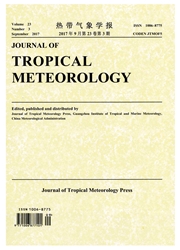

 中文摘要:
中文摘要:
Using the WRF(Weather Research Forecast)model,this work performed analysis and simulation on the rainband change during the landfall of Typhoon Haitang(2005)and found that breaking may occur over land and oceans leads to distinct asymmetric precipitation.The breaking is related to the topographic effect as well as interactions between the typhoon and midlatitude systems at upper levels.During the landfall,divergent flows at the 200-hPa level of the South-Asian high combined with divergent flows at the periphery of the typhoon to form a weak,inverted trough in the northwest part of the storm,with the mid- and low-level divergence fields on the west and northwest side of the typhoon center maintaining steadily.It intensifies the upper-level cyclonic flows,in association with positive vorticity rotating counterclockwise together with air currents that travel stepwise into a vorticity zone in the vicinity of the typhoon core, thereby forming a vorticity transfer belt in 22–25°N that extends to the eastern part of the storm.It is right here that the high-level vorticity band is subsiding so that rainfall is prevented from developing,resulting in the rainbelt breaking,which is the principal cause of asymmetric precipitation occurrence.Migrating into its outer region,the banded vorticity of Haitang at high levels causes further amplification of the cyclonic circulation in the western part and transfer of positive vorticity into the typhoon such that the rainband breaking is more distinct.
 英文摘要:
英文摘要:
Using the WRF(Weather Research Forecast)model,this work performed analysis and simulation on the rainband change during the landfall of Typhoon Haitang(2005)and found that breaking may occur over land and oceans leads to distinct asymmetric precipitation.The breaking is related to the topographic effect as well as interactions between the typhoon and midlatitude systems at upper levels.During the landfall,divergent flows at the 200-hPa level of the South-Asian high combined with divergent flows at the periphery of the typhoon to form a weak,inverted trough in the northwest part of the storm,with the mid- and low-level divergence fields on the west and northwest side of the typhoon center maintaining steadily.It intensifies the upper-level cyclonic flows,in association with positive vorticity rotating counterclockwise together with air currents that travel stepwise into a vorticity zone in the vicinity of the typhoon core, thereby forming a vorticity transfer belt in 22–25°N that extends to the eastern part of the storm.It is right here that the high-level vorticity band is subsiding so that rainfall is prevented from developing,resulting in the rainbelt breaking,which is the principal cause of asymmetric precipitation occurrence.Migrating into its outer region,the banded vorticity of Haitang at high levels causes further amplification of the cyclonic circulation in the western part and transfer of positive vorticity into the typhoon such that the rainband breaking is more distinct.
 同期刊论文项目
同期刊论文项目
 同项目期刊论文
同项目期刊论文
 Microphysical and radiative effects of ice clouds on responses of rainfall to the large-scale forcin
Microphysical and radiative effects of ice clouds on responses of rainfall to the large-scale forcin Sensitivity of cloud-resolving precipitation simulations to uncertainty of vertical structures of in
Sensitivity of cloud-resolving precipitation simulations to uncertainty of vertical structures of in Roles of large-scale forcing, thermodynamics, and cloud microphysics in tropical precipitation proce
Roles of large-scale forcing, thermodynamics, and cloud microphysics in tropical precipitation proce 期刊信息
期刊信息
